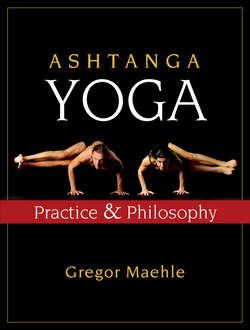Читать книгу Ashtanga Yoga - Gregor Maehle - Страница 35
На сайте Литреса книга снята с продажи.
Vinyasa One
ОглавлениеAt the beginning of the inhalation turn the palms out and reach far out to the sides and up, embracing as much space as possible until your palms are together above your head. The neck should always move as an extension of the spine, as indeed it is. The gaze lifts at the same pace as the lift of the arms. When the palms meet we are gazing up to the thumbs. The movement of the arms, the shifting of the gaze, and the movement of the breath should all be perfectly synchronized. This needs to be deeply understood, as it applies to the whole of the practice.
The lifting of the arms originates deep in the abdomen. This is done by hooking the breath into the abdomen and letting the power of the inhalation lift the arms. All lifting and upward movements are performed on the inhalation. The breath initiates each move and brings intelligence, grace, and ease to movement and posture.
When raising the arms, prevent hunching the shoulders up around the ears by actively drawing the shoulder blades down the back. This not only looks more elegant, but also prevents jamming of the neck (cervical) vertebrae and sets the correct pattern for arm balances and backbends. When looking up, do not throw the head back so that the face is parallel to the ceiling. This would be done either by collapsing the back of the neck or by overcontracting the trapezius muscle at the back of the neck.
ANATOMICAL FOCUS
Latissimus Dorsi
The action of the latissimus dorsi in drawing the shoulder blades toward the hips is anatomically called the depression of the shoulder girdle. Belonging to the outermost layer of muscles on the body, this muscle is difficult to overwork — in fact strengthening and toning of the latissimus dorsi relieves the burden usually placed on the trapezius and the other muscles that elevate the shoulder blades. The ideal approach is to commence training this muscle early.
Either way, it achieves no strength and offers no support to the neck. Instead, lift the chin to the ceiling, elongate the neck and the trapezius by engaging the latissimus dorsi muscle (the muscle that draws the shoulder blades down the back), and keep the back of the neck supported.
The head gently tilts on the atlas, the first of the neck vertebra. In Greek mythology, Atlas was the god who carried the world on his shoulders. This vertebra is also called C1, being the first of the seven cervical vertebrae.
